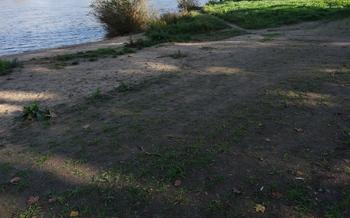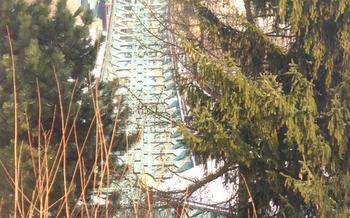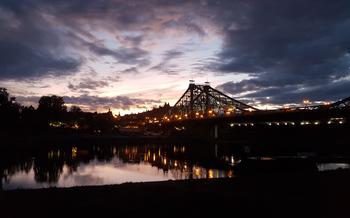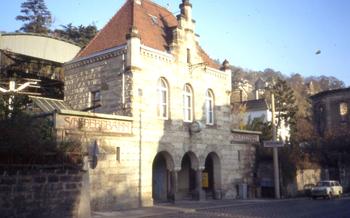
Hiking and Climbing in the Saxon Switzerland National Park
- Saxon Switzerland National Park: A Climber's Paradise
- Planning Your Trip
- Getting Started
- Popular Climbing Routes
- Climbing Equipment: Gearing Up for Success
- Safety First: Climbing Responsibly in Saxon Switzerland
- Rock Climbing for Beginners
- Rock Formations and Geology
- History of Climbing in Saxon Switzerland
- Accommodation and Dining:
- Hiking Trails: Explore the Natural Wonders on Foot
- Photography Opportunities
- Local Culture and Traditions:
- Environmental Conservation
- Insider Tip: Explore the Hidden Gems of the Saxon Switzerland National Park:
Saxon Switzerland National Park: A Climber's Paradise
Nestled in the heart of Eastern Germany, Saxon Switzerland National Park stands as a haven for climbers worldwide. With its captivating history, awe-inspiring geography, and iconic rock formations, this natural wonder beckons adventurers to explore its vertical wonders.
Formed over millions of years by the erosive forces of the Elbe River, the park's captivating landscape features towering sandstone cliffs, deep gorges, and a labyrinth of rock pillars that create a climbers' paradise. These unique formations, known as "Saxon Switzerland," offer a vast array of climbing routes and challenges for climbers of all skill levels.
The park's climbing routes cater to both beginners and seasoned adventurers. Whether you're a novice seeking an introduction to the sport or an experienced climber looking for a thrilling challenge, Saxon Switzerland National Park has something to offer. Embrace the thrill of scaling sheer rock faces, conquering technical chimneys, and experiencing the unparalleled rush of reaching the summit.
Planning Your Trip
Before embarking on your climbing adventure in Saxon Switzerland National Park, proper planning is essential. The ideal time to visit the park is during the spring (April-May) or autumn (September-October) when the weather is pleasant and stable. Summers can be hot and crowded, while winters can be cold with limited climbing opportunities due to snow and ice.
Getting to the park is easy, with several transportation options available. The nearest major airport is Dresden Airport, located about 45 minutes away by car or public transportation. From Dresden, you can take a train to Bad Schandau, the gateway town to the park. From there, buses and ferries connect to various trailheads and climbing areas.
Before heading out, gather essential information such as maps, guidebooks, and weather forecasts. The park's visitor center in Bad Schandau is a great resource for maps, climbing information, and tips. Checking the weather forecast regularly is crucial, as conditions can change rapidly in the mountains. Come prepared with appropriate clothing and gear for all weather conditions, including rain and cold temperatures.
Getting Started
When planning your climbing adventure in Saxon Switzerland National Park, it's crucial to choose the right climbing route that matches your skill level. For beginners, it's advisable to start with easier routes and gradually work your way up as you gain experience. Several local climbing schools and guides are available to help you get started, providing instruction on basic techniques, safety protocols, and route selection.
If you're bringing your own equipment, ensure it is in good condition and appropriate for the type of climbing you'll be doing. Alternatively, you can rent equipment from local shops in the park or nearby towns. Remember to wear a helmet and appropriate footwear for added safety.
Safety is paramount when rock climbing. Always use ropes and harnesses, and follow established safety protocols. Be aware of potential hazards such as falling rocks, slippery surfaces, and exposure to heights. Knowing your limits and climbing within your abilities is essential to prevent accidents.
Popular Climbing Routes
Saxon Switzerland National Park offers a wide range of climbing routes for climbers of all skill levels, from beginners to seasoned veterans. Some of the most popular routes include:
- Schrammsteine: This is one of the most iconic climbing areas in the park, renowned for its impressive sandstone towers and stunning views. It offers a variety of routes, from easy to challenging, making it suitable for climbers of all abilities.
- Affensteine: Known for its unique rock formations, Affensteine is a great choice for experienced climbers. It offers challenging routes with technical moves and exposed sections, providing an exhilarating climbing experience.
- Pfaffenstein: With its distinctive table-top summit, Pfaffenstein is a popular destination for both climbers and hikers. It offers a variety of routes, including several long multi-pitch climbs, making it ideal for those seeking a full day of adventure.
Whether you're a beginner looking for your first climb or an experienced climber seeking a challenging route, Saxon Switzerland National Park has something to offer. The park's stunning scenery and variety of routes make it a must-visit destination for climbers worldwide.
Climbing Equipment: Gearing Up for Success
Whether you're a seasoned climber or just starting, having the right climbing equipment is crucial for a safe and enjoyable experience in Saxon Switzerland National Park. Here's what you need to know:
Essential Gear: The foundation of your climbing kit includes a rope, harness, helmet, and climbing shoes. These are non-negotiable items that ensure your safety and comfort on the rock.
Rope: Choose a dynamic rope that can absorb the impact of a fall. The length of the rope depends on the height of the climbs you'll be doing.
Harness: A full-body harness distributes the force of a fall evenly, minimizing injury. Make sure it fits snugly and comfortably.
Helmet: A helmet protects your head from falling rocks and other debris. Choose one that is lightweight and fits securely.
Climbing Shoes: Climbing shoes provide the necessary grip and support for your feet on the rock. Choose a pair that fits snugly but doesn't cause discomfort.
Other Gear: Depending on your needs, you may also want to bring along a chalk bag to keep your hands dry, a belay device to control the rope during climbing, and quickdraws to connect your rope to the rock.
Renting or Buying: You can rent climbing equipment at various locations in the park or nearby towns. If you plan on climbing regularly, it may be more cost-effective to purchase your own gear.
Choosing the Right Gear: When selecting your equipment, consider your skill level, the type of climbing you'll be doing, and your budget. Expert advice from a climbing shop can help you make informed choices.
Safety First: Always inspect your equipment thoroughly before each climb. Look for signs of wear, fraying, or damage. Replace any questionable gear immediately.
Safety First: Climbing Responsibly in Saxon Switzerland
Climbing in Saxon Switzerland offers a thrilling adventure, but safety should always be a top priority, especially for beginners. The park's rugged terrain and challenging routes can pose risks if proper precautions aren't taken. Here are some essential safety tips:
-
Know Your Limits: Assess your climbing skills and fitness level honestly. Choose routes that match your abilities and experience, and don't push yourself beyond your comfort zone.
-
Proper Equipment: Ensure you have the right climbing gear, including a helmet, harness, ropes, and appropriate footwear. Inspect your equipment regularly for damage or wear.
-
Follow Safety Protocols: Always use ropes and harnesses when climbing, and make sure they are properly attached and secured. Follow the park's safety regulations and guidelines, and be aware of any potential hazards or restrictions.
-
Be Aware of Your Surroundings: Pay attention to the terrain, weather conditions, and other climbers around you. Be mindful of loose rocks, slippery surfaces, and exposure to heights.
-
Climb with a Partner: Climbing with a partner is safer and more enjoyable. Keep an eye on each other, communicate effectively, and be ready to assist if needed.
-
Check the Weather: Before you head out, check the weather forecast and be prepared for changing conditions. Climbing in wet or icy conditions can be dangerous.
-
Learn Proper Techniques: Take the time to learn the basics of rock climbing, including foot and hand placement, balance, and rope handling. Practice these techniques on easier routes before attempting more challenging ones.
-
Don't Overestimate Your Abilities: It's tempting to push your limits, but it's important to be realistic about your skills and experience. Overestimating your abilities can lead to dangerous situations.
By following these safety tips, you can minimize risks and maximize your enjoyment while climbing in Saxon Switzerland. Remember, safety is not just about protecting yourself but also about respecting the environment and other climbers.
Rock Climbing for Beginners
Saxon Switzerland National Park is an excellent place for beginners to learn the basics of rock climbing. Several beginner-friendly climbing routes and areas are available, and local climbing schools and guides can help you get started.
When choosing a climbing route, it's essential to consider your fitness level and climbing experience. Start with easy routes and gradually increase the difficulty as you gain confidence and skills. Patience and perseverance are essential, as learning to rock climb takes time and practice.
Local climbing schools and guides can provide valuable instruction and support for beginners. They can teach you the proper techniques for foot and hand placement, balance, and rope handling, ensuring your safety and helping you progress.
Remember to start with easy routes and gradually increase the difficulty as you gain experience. Patience and perseverance are essential, as learning to rock climb takes time and practice. Don't be afraid to take breaks and ask for help when needed. With the right approach and guidance, you'll be able to enjoy the thrill and satisfaction of rock climbing in Saxon Switzerland National Park.
Rock Formations and Geology
Saxon Switzerland National Park is renowned for its breathtaking rock formations, which are a testament to millions of years of geological processes. The park's unique landscape is characterized by towering sandstone pillars, majestic arches, and sheer cliffs that rise from the lush forests. These formations were shaped by the erosive forces of wind, water, and ice, which carved the soft sandstone into the distinctive shapes we see today.
The most famous of these rock formations is the Bastei Bridge, a natural sandstone arch that spans a deep gorge and offers stunning views of the surrounding countryside. Other notable formations include the Schrammsteine, a series of jagged peaks that resemble a row of teeth, and the Pfaffenstein, a massive table-top mountain that offers panoramic views from its summit.
The geology of Saxon Switzerland is equally fascinating. The park is located on the Elbe Sandstone Formation, which is composed of sedimentary rocks that were deposited over millions of years. These rocks contain fossils of ancient plants and animals, providing a glimpse into the region's prehistoric past.
Visitors to Saxon Switzerland can learn more about the park's geology at the National Park Center in Bad Schandau. The center features interactive exhibits and displays that explain the geological processes that shaped the park's landscape. Guided tours are also available, providing an opportunity to explore the park's rock formations up close and learn about their unique features.
History of Climbing in Saxon Switzerland
The history of climbing in Saxon Switzerland dates back to the early 19th century when the region's unique rock formations and challenging terrain attracted the attention of adventurous climbers. One of the pioneers of climbing in the park was the German artist and mountaineer, Caspar David Friedrich, who immortalized the park's dramatic landscapes in his paintings. In the late 19th and early 20th centuries, climbing in Saxon Switzerland gained popularity among German and Austrian climbers, who established many of the classic routes that are still enjoyed today.
Notable climbers who made significant contributions to the sport in the park include Rudolf Fehrmann, who made the first ascent of the Schrammsteine in 1864, and Oskar Schuster, who established numerous new routes in the 1920s and 1930s. After World War II, climbing in Saxon Switzerland experienced a revival, and the park became a popular destination for climbers from all over the world. Today, the park is home to a vibrant climbing community, and it continues to attract climbers of all skill levels who come to experience the unique challenges and beauty of its rock formations.
Accommodation and Dining:
Saxon Switzerland National Park is surrounded by charming towns and villages that offer a variety of accommodation options for climbers. From budget-friendly hostels and guesthouses to comfortable hotels and cozy cabins, there's something to suit every taste and budget.
For those seeking a more immersive experience, camping is a fantastic option. Several campsites are located near the park, allowing climbers to camp under the stars and wake up to breathtaking views of the rock formations.
When it comes to dining, the region offers a delightful culinary experience. From traditional German cuisine to international flavors, there's something to satisfy every palate. Be sure to try local specialties such as "Sächsische Kartoffelklöße" (potato dumplings) and "Dresdner Christstollen" (fruit bread).
After a day of climbing, climbers can unwind and socialize at one of the many restaurants, cafes, or bars in the area. Many establishments cater specifically to climbers, offering hearty meals, refreshing drinks, and a friendly atmosphere.
By supporting local businesses, climbers can contribute to the local economy and experience the region's rich culinary traditions.
Hiking Trails: Explore the Natural Wonders on Foot
The Saxon Switzerland National Park offers a diverse network of hiking trails that cater to hikers of all levels, from leisurely strolls to challenging mountain hikes. Whether you prefer a gentle walk along the Elbe River or a strenuous climb to the summit of a sandstone peak, the park has something for everyone.
One of the most popular hiking trails in the park is the Malerweg (Painters' Way), a long-distance trail that stretches for over 110 kilometers through the most scenic parts of the park. The trail takes its name from the many artists who have been inspired by the park's stunning landscapes. Along the way, hikers will encounter towering rock formations, deep gorges, and lush forests.
Another popular trail is the Elbsandsteingebirge Trail, which follows the Elbe River for over 200 kilometers. This trail offers stunning views of the river and the surrounding countryside. Hikers can choose to walk the entire trail or just a section of it.
For those looking for a more challenging hike, there are several trails that lead to the summits of the park's highest peaks. These hikes offer breathtaking panoramic views of the surrounding countryside.
No matter what your fitness level or interests, you're sure to find a hiking trail in the Saxon Switzerland National Park that's perfect for you. Just be sure to wear comfortable shoes, bring plenty of water, and follow the marked trails.
Photography Opportunities
Saxon Switzerland National Park is a photographer's paradise, offering endless opportunities to capture the beauty of its natural wonders. From panoramic vistas of verdant valleys and towering rock formations to close-ups of intricate rock textures and delicate wildflowers, the park provides a feast for the eyes.
The best time to photograph the park is during the golden hours of sunrise and sunset, when the warm light casts a magical glow on the landscape. For dramatic shots, try capturing the park's iconic rock formations against the backdrop of a stormy sky or a vibrant sunset.
To capture the essence of the park's diverse flora and fauna, venture off the beaten path and explore its hidden corners. Look for delicate wildflowers blooming in the crevices of rocks, or capture the antics of playful squirrels and birds against the backdrop of the stunning scenery.
Remember to respect the park's environment and wildlife while taking photos. Stick to designated trails, avoid disturbing wildlife, and use a telephoto lens to capture close-up shots without getting too close to the animals.
Share your stunning captures with the world and inspire others to explore the beauty of Saxon Switzerland National Park through your lens.
Local Culture and Traditions:
Saxon Switzerland National Park is steeped in a rich cultural heritage that blends German and Slavic influences. The region's unique history has shaped its traditions, language, and customs, creating a vibrant cultural tapestry that visitors can explore.
One of the highlights of the local culture is the annual Saxon Switzerland Festival, held in the town of Rathen. This lively festival celebrates the region's climbing heritage and features traditional music, dance, and food. Visitors can witness spectacular climbing demonstrations and competitions, as well as enjoy local crafts and specialties.
The region's cuisine is also a testament to its cultural diversity. Climbers can refuel after a day of adventure with hearty dishes like Saxon potato pancakes, smoked meats, and dumplings. Local breweries offer a variety of craft beers to quench your thirst and provide a taste of the region's brewing traditions.
To delve deeper into the local culture, visitors can explore the region's many museums and historical sites. The Saxon Switzerland Museum in Pirna showcases the park's natural and cultural history, while the Königstein Fortress offers a glimpse into the region's military past.
By embracing the local culture and traditions, visitors can gain a deeper appreciation for the unique character of Saxon Switzerland National Park and create lasting memories of their visit.
Environmental Conservation
As you embark on your adventure in Saxon Switzerland National Park, it's essential to remember that you are a guest in this incredible natural wonderland. Protecting the park's delicate ecosystem and rich biodiversity is crucial for ensuring its beauty and accessibility for future generations. Here are some tips for being a responsible traveler:
-
Tread Lightly: Stay on marked trails to avoid disturbing wildlife and fragile plant life.
-
Leave No Trace: Pack out everything you bring in, including food scraps and waste.
-
Respect Wildlife: Observe animals from a distance and never feed them.
-
Support Conservation: Consider donating to local conservation organizations or participating in volunteer projects.
By following these simple guidelines, you can help preserve the magic of Saxon Switzerland National Park for years to come.
Insider Tip: Explore the Hidden Gems of the Saxon Switzerland National Park:
Beyond the popular climbing routes, the Saxon Switzerland National Park hides secret climbing spots known only to locals and experienced climbers. One such hidden gem is the Geisterloch, a secluded cave located in the heart of the park. To reach this hidden spot, follow the trail from the village of Hohnstein towards the Polenztal valley. After about an hour of hiking, you'll find a small path leading into the forest on your left. Follow this path for another 15 minutes, and you'll come across the entrance to the Geisterloch.
The cave offers a variety of climbing routes, ranging from easy to challenging, making it suitable for climbers of all skill levels. The highlight of the cave is the "Geisterwand", a 30-meter-high rock face with several challenging routes that will test your skills and endurance.
Remember to bring your own climbing gear, as there are no rental facilities in the cave. Also, be prepared for changing weather conditions and slippery surfaces inside the cave. Climbing in the Geisterloch is a unique experience that combines the thrill of climbing with the beauty of the surrounding nature. So, if you're looking for an off-the-beaten-path adventure, make sure to explore this hidden gem of the Saxon Switzerland National Park.









